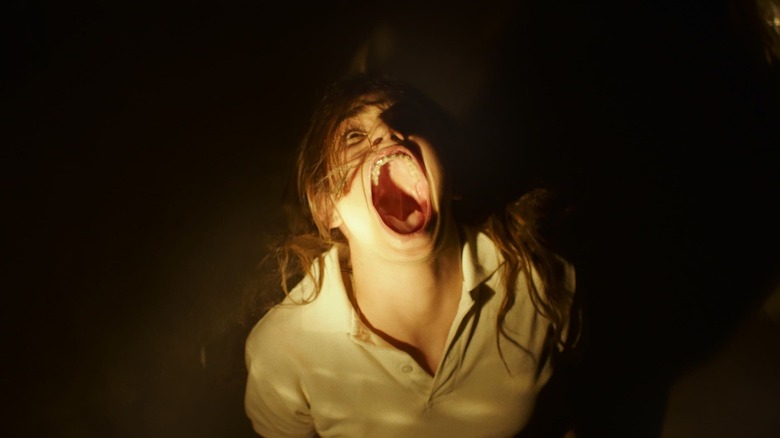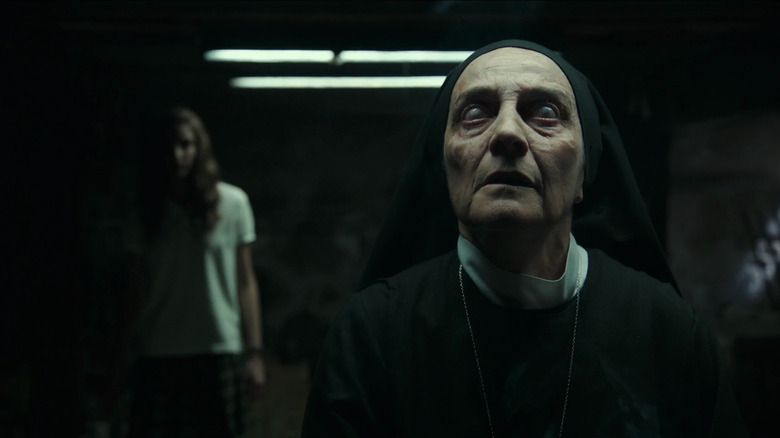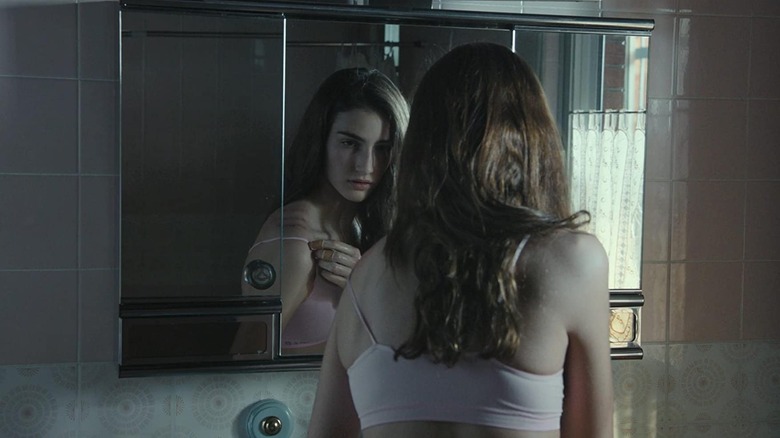Some Viewers Are Too Scared To Finish Netflix's Spanish Horror Movie Verónica
When Paco Plaza's Spanish horror film "Verónica" was released in North America in 2017, it instantly received acclaim for its insidious sense of dread, and for some of its more terrifying images. There is a scene about halfway through "Verónica" where the title character (Sandra Escacena) is walking through her apartment, and a shadowy, ghostly figure is standing in the hallway behind her, merely watching. There's no musical sting, and nothing about the camera placement that suggests the photographer even sees the ghost. Verónica doesn't even seem to notice. And yet it is undoubtedly there.
Like many horror films of recent vintage, "Verónica" is a film about mourning, trauma, and domestic strife. The ghost glimpsed in the hallway may very well be the ghost of her father who passed away recently. Verónica, just 15, wasn't quite permitted to grieve, as she's had to become a more parental figure for her two younger siblings — she had to essentially become her father. This metaphor becomes explicit when she and some friends elect to hold a séance in their school's basement, and she seemingly evokes ... well, something. Something that is coming through her, warping her perspective, and giving her nightmares.
In what might be the film's scariest scene, Verónica is awakened in her bed by her little brother and sister. She is exhausted, but they giggle and make demands. They're hungry. Before she can get up to feed them, the children begin taking massive bites out of Verónica's flesh. She screams, but the children continue giggling and eating. It's a dream sequence, but the message is clear. Verónica feels like she's being eaten alive.
Around the time of its release, some called it the scariest horror film of all time, and even now, viewers are talking about how the film is so scary, they can't make it all the way through.
Based on a true story
It also may be terrifying to learn that "Verónica" was inspired by true events. The film is set in 1991, and mirrors details in the death of a girl named Estefanía Gutiérrez Lázaro who died that year. The story goes (and it was explored in the pages of NME) that Lázaro, too, held a séance in her school's basement and also began experiencing strange, violent hallucinations shortly thereafter. In "Verónica," the title character and her friend attempt to contact a recently dead boyfriend as well as Verónica's father. In real life, it was also a case of trying to evoke a recently dead boyfriend. Lázaro began having seizures and other attacks of unknown origin. Her actual cause of death was unknown.
Paco Plaza wasn't telling Lázaro's story, of course, but used it as inspiration for his fictionalized version. This is common for a lot of horror classics: Wes Craven was inspired to write "A Nightmare on Elm Street" after hearing stories of a teenage boy who was afraid he would die in his sleep, and William Peter Blatty based "The Exorcist" on a real case of supposed demonic possession.
The plot of "Verónica" goes to some pretty predictable places after the demon is discovered and characters begin staging counter-seances to combat it. There's a creepy, milk-eyed nun and a final confrontation with the specter that's not nearly as scary as the film's first half. But that first half really digs under the skin. The central image, of Verónica screaming out of a mouth that seems a little too large for her head, burns its way into memory.
One of the first in a recent wave?
It's almost become a cliché to say that a film or TV show is symbolic of trauma. While one can understand how an audience growing up in a post-9/11 world might be drawn to stories of trauma, the theme has become so pervasive, it's almost become cheap. Audiences can now see the android Vision (Paul Bettany), half of the starring couple in the Marvel TV series "WandaVision," earnestly delivering lines of dialogue like "What is grief, if not love persevering?"
The film "Verónica" is only six years old, and yet seems to have codified grief and trauma as explicit themes in pop entertainment long before some of its contemporaries. And even if it wasn't the first, it was certainly a heck of a lot better than some of its American counterparts. A big appeal of "Verónica" is that it took a lot of audiences completely by surprise. It wasn't a high-profile release or a widespread American studio film with big stars and a huge budget. It was a modest Spanish production that debuted on Netflix with little fanfare. It found its audience organically, making its word-of-mouth feel all the more authentic.
Not everyone loved "Verónica," of course. Its approval rating on Rotten Tomatoes is a respectable 88%, revealing several critics who were unimpressed. But as something to watch late at night with the lights out, it's slick and exciting and will leave you going to bed with the lights on. And that's not nothing.


